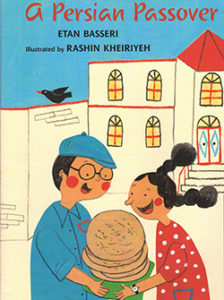A Persian Passover by Etan Basseri (Illustrated by Rashin Kheiriyeh); Moosic, Pennsylvania: Kalaniot Books, © 2022; ISBN 9781735-087566; 32 pages including glossary; $19.99.

 SAN DIEGO – The red-cheeked children on the cover of this charming little story are Ezra, who likes to run, and his little sister, Roza, who adores her big brother. Unfortunately, Ezra is in such a rush to set a running speed record, that he doesn’t watch where he is going. As Roza times a dash around the block, Ezra crashes into kindly Mrs. Pirnazar, spilling her laundry basket.
SAN DIEGO – The red-cheeked children on the cover of this charming little story are Ezra, who likes to run, and his little sister, Roza, who adores her big brother. Unfortunately, Ezra is in such a rush to set a running speed record, that he doesn’t watch where he is going. As Roza times a dash around the block, Ezra crashes into kindly Mrs. Pirnazar, spilling her laundry basket.
She doesn’t yell at him. She simply says, “It’s good to be fast, but it’s also important to be careful.”
With the approach of Passover, Ezra’s job is to take the flour to the traditional matzo bakers, who make a verity that is soft rather than crunchy. Then, Ezra is supposed to bring the matzo home in time for the seder. So what happens? Ezra races home, slips on a puddle, and ruins all the matzo.
He and Rosa go back to the market place to see if anyone has more matzo, but no one does, although the kind people bestow on him and Roza such treats as scallions (for pretending to lash each other during the seder ceremony) and candied almonds.
When Roza and Ezra approach their home, they know they will have to tell their parents there is no matzo for the seder, nor for the rest of Passover week. But kindly Mrs. Pirnazar happens by with a basket filled with matzo. She says she has more than enough, and the children invite her to join them at the family seder, where the children’s parents express gratitude to Mrs. Pirnazar on her kindness, and Ezra having learned his lesson that it’s good to be fast, but it’s also important to be careful.
The glossary teaches us some of the unfamiliar words used in the story. Khanoum is Persian (Farsi) for “Ma’am;” Joon means “Dear” and Moadim shalom is a Persian holiday greeting.
We can also learn quite a bit from the illustrations. The cover depicts the two children looking at the soft Persian matzos, which look to my eyes as a cross between pita bread and a tortilla. We see how that matzo is made and for how long it is cooked. We see some traditional Persian modes of dress, circa 1950. And we note the family sitting in bare feet on a carpet enjoying a Passover seder that has been spread out on a rug. At the end of the book, there is a short essay on Jewish life in pre-Revolutionary Iran as well as a recipe for Hallaq, which is Persian-style charoseth.
*
Donald H. Harrison is editor emeritus of San Diego Jewish World. He may be contacted via donald.harrison@sdjewishworld.com